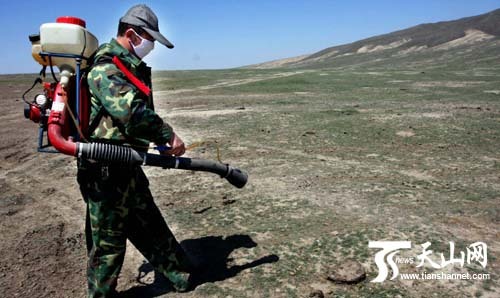An 8,000 hectare pasture in northwest China's Xinjiang Uygur Autonomous Region affected by an unusual worm infestation earlier this month has declared pest-free Wednesday.
 |
|
Photo taken on May 9, 2009 shows a staff member sprays pesticide on the grassland in northwest China's Xinjiang Uygur Autonomous Region. An 8,000 hectare pasture there affected by an unusual worm infestation earlier this month has declared pest-free Wednesday.
|
"The pasture will be open to grazing in the autumn," said Zhang Xishan, an official in charge of grassland management, on Thursday, adding that the residual pesticide will decompose in a week, and pose no danger to livestock in the fall.
About 20,000 heads of livestock and 50 families of herdsmen were forced to leave the Usu grassland earlier than planned in the first week of May after a massive invasion of unidentified worms at the end of April.
The Xinjiang regional headquarters of locust and rodent control sent two spray vehicles carrying pesticide to Usu to fight the worm plague on May 8. The operation lasted nine days, said Zhang Quan, an official with the headquarters.
More than 1,800 kg of cypermethrin, a kind of broad-spectrum pesticide, was used to treat the pasture, said Zhang Quan.
"It (the pesticide) won't affect the soil quality and grass there," said Zhang Quan.
The worms, with a density of up to 3,000 per square meter, consumed the grassland like mowers, leaving only the brown soil behind them, said Zhang Quan.
However, experts have been unable to identify the worm.
Zhang Quan said the worms might be moth larvae. He suggested the warm winter and plenty of rain this spring might have helped produce the army of worms.
"The only way to identify the worm is when it becomes a moth, and then we can identify the worm by its size, stripes, color, antenna, wings, and reproductive organs," said Gao Song, an associate researcher of the Chinese Academy of Agricultural Sciences.
He said that there is no clear sign for the worm to become a moth, and maybe the worm is at the diapause period, or summer dormant.
"We have worm samples in our lab, and we are still waiting for them to grow to the moth stage, maybe next week, or maybe in autumn."
This was the worst plague of worms over the past three decades in the city that is 280 km west of the regional capital of Urumqi, said Zhang Quan.
Xinjiang has a history of using chickens, ducks and birds to fight locusts, which are also a menace to grassland. However, these birds showed no interests in the thorny worms in Usu.